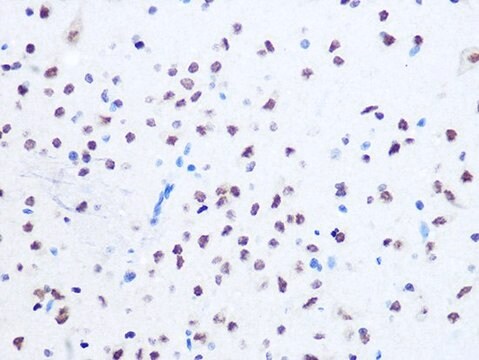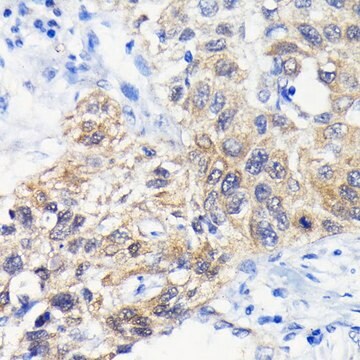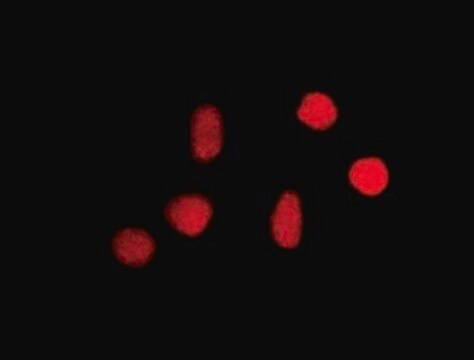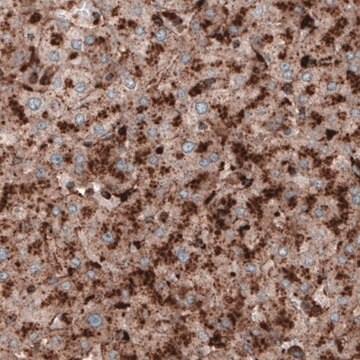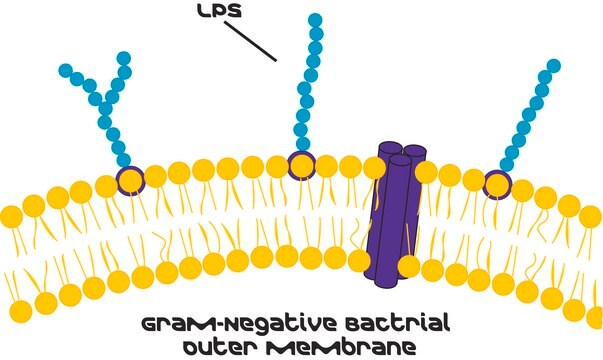ABE1372
Anti-OGG1 Antibody
from rabbit, purified by affinity chromatography
Synonym(s):
N-glycosylase/DNA lyase, 1.8-oxoguanine DNA glycosylase, DNA-(apurinic or apyrimidinic site) lyase, AP lyase
Sign Into View Organizational & Contract Pricing
Select a Size
All Photos(1)
Select a Size
Change View
About This Item
UNSPSC Code:
12352203
eCl@ss:
32160702
NACRES:
NA.41
Recommended Products
General description
The protein named N-glycosylase/DNA lyase or alternatively, 8-oxoguanine (8-OxoG) DNA glycosylase or AP lyase, and encoded by the gene named OGG1/MMH/MUTM/OGH1, is a DNA repair enzyme that incises DNA at 8-oxoG residues and excises 7,8-dihydro-8-oxoguanine and 2,6-diamino-4-hydroy-5-N-methylformamidopyrimidine (FAPY) from damaged DNA. OGG1 also has beta-lyase activity that nicks DNA 3′ to the lesion. OGG1 is localized to the nucleus and nucleoplasm; in UVA-irradiated cells it can be found in the nuclear speckles. There is also an isoform found in the mitochondrion. Interestingly, OGG1 appears to be play a critical role in repairing mtDNA damage; mtDNA damage is linked to mitochondrial dysfunction, increased oxidative stress, and insulin resistance in muscle cells, and studies using OGG1 knockouts or over expressing OGG1 demonstrate that OGG1 is important for proper mtDNA damage repair and that disruption of OGG1 can lead to increased mtROS (reactive oxygen species) production and subsequent regulation of downstream events leading to insulin resistance in skeletal muscle. OGG1, or rather defects in OGG1 function, are also associated with a number of carcinomas, particularly Renal Cell Carcinomas of various cell types.
Immunogen
Recombinant protein corresponding to human OGG1.
Application
Research Category
Epigenetics & Nuclear Function
Epigenetics & Nuclear Function
Research Sub Category
Nuclear Receptors
Nuclear Receptors
This Anti-OGG1 Antibody is validated for use in Western Blotting for the detection of OGG1.
Western Blotting Analysis: A representative lot detected recombinant protein OGG1 (Bjoras, M., et al. (1997). EMBO. 16(20):6314–6322).
Western Blotting Analysis: A representative lot detected OGG1 in Melphalan-resistant cells (Sousa, M., et al. (2013). PLOS One. 8(2):e55493).
Western Blotting Analysis: A representative lot detected OGG1 in Melphalan-resistant cells (Sousa, M., et al. (2013). PLOS One. 8(2):e55493).
Quality
Evaluated by Western Blotting in recombinant protein OGG1.
Western Blotting Analysis: A 1:1,000 dilution of this antibody detected recombinant protein OGG1 in 1 µg of cell lysate.
Western Blotting Analysis: A 1:1,000 dilution of this antibody detected recombinant protein OGG1 in 1 µg of cell lysate.
Target description
~38 kDa observed
Physical form
Affinity purified
Purified rabbit polyclonal in buffer containing PBS with 0.05% sodium azide.
Storage and Stability
Stable for 1 year at 2-8°C from date of receipt.
Other Notes
Concentration: Please refer to lot specific datasheet.
Disclaimer
Unless otherwise stated in our catalog or other company documentation accompanying the product(s), our products are intended for research use only and are not to be used for any other purpose, which includes but is not limited to, unauthorized commercial uses, in vitro diagnostic uses, ex vivo or in vivo therapeutic uses or any type of consumption or application to humans or animals.
Not finding the right product?
Try our Product Selector Tool.
Storage Class
10 - Combustible liquids
wgk_germany
WGK 2
flash_point_f
Not applicable
flash_point_c
Not applicable
Certificates of Analysis (COA)
Search for Certificates of Analysis (COA) by entering the products Lot/Batch Number. Lot and Batch Numbers can be found on a product’s label following the words ‘Lot’ or ‘Batch’.
Already Own This Product?
Find documentation for the products that you have recently purchased in the Document Library.
M Bjorâs et al.
The EMBO journal, 16(20), 6314-6322 (1997-10-08)
The guanine modification 7,8-dihydro-8-oxoguanine (8-oxoG) is a potent premutagenic lesion formed spontaneously at high frequencies in the genomes of aerobic organisms. We have characterized a human DNA repair glycosylase for 8-oxoG removal, hOGH1 (human yeast OGG1 homologue), by molecular cloning
Mirta M L Sousa et al.
PloS one, 8(2), e55493-e55493 (2013-02-14)
Alterations in checkpoint and DNA repair pathways may provide adaptive mechanisms contributing to acquired drug resistance. Here, we investigated the levels of proteins mediating DNA damage signaling and -repair in RPMI8226 multiple myeloma cells and its Melphalan-resistant derivative 8226-LR5. We
Our team of scientists has experience in all areas of research including Life Science, Material Science, Chemical Synthesis, Chromatography, Analytical and many others.
Contact Technical Service